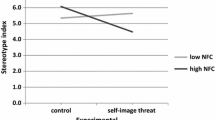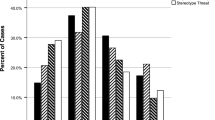Abstract
We provide evidence that stereotype threat, a phenomenon that causes stigmatized individuals to experience group-based evaluative concerns (Steele in Am Psychol 52:613–629, 1997; Whistling Vivaldi and other clues to how stereotypes affect us, W.W. Norton, New York, 2010), impacts affective aspects of Black identity as a function of majority versus minority ecological contexts. Black/African-American students, enrolled in either Africana Studies (Black ecological majority) or Psychology (Black ecological minority), completed private and public regard subscales from the Multidimensional Inventory of Black Identity (Sellers et al. in Pers Soc Psychol Rev 2:18–39, 1998) at baseline (Time 1) and after being randomly assigned to a stereotype threat or no-threat/control condition (Time 2). In threat, participants were introduced to a ‘puzzle’ task as diagnostic of intellectual abilities, whereas in no-threat the same task was introduced as culture fair, such that people from different racial/ethnic groups had performed similarly on this task in the past. In Psychology, students under threat exhibited a simultaneous decrease and increase in private and public regard, respectively, a pattern shown in the literature to be associated with discrimination-based distress and lesser well-being in Black ecological minority environments. In contrast, Africana Studies students’ racial identity under threat remained intact. We discuss the protective effects of Africana Studies on racial identity and implications for educational reform.

Similar content being viewed by others
Notes
Black students enrolled in Psychology and Africana studies at SF State were comparable on several factors such as gender (78.5% female and 65.5% female, respectively), modal age range (18–24 in both), enrollment status (89.2 and 86.2% full time, respectively), and regional origin (100% from CA in both) (retrieved from, http://air.sfsu.edu/enrollment_reports, 8. 8. 2017).
The logistics of conducting a laboratory study at a commuter university in which most students hold at least one job proved prohibitive. We thus shifted to an online format. There were no statistically significant differences between the first 12 participants and the rest, all ps > .12.
References
Aronson, J., Lustina, M. J., Good, C., Keough, K., Steele, C. M., & Brown, J. (1999). When white men can’t do math: Necessary and sufficient factors in stereotype threat. Journal of Experimental Social Psychology, 35, 29–46.
Astin, H. S., & Sax, L. (1996). Developing scientific talent in undergraduate women. In C. S. Davis, A. Ginorio, C. Hollenshead, B. Lazarus, & P. Rayman (Eds.), The equity equation: Fostering the advancement of women in the sciences, mathematics, and engineering. San Francisco, CA: Josse-Bass.
Ben-Zeev, A., & Kirtman, N. (2012). Stereotype threat beyond the laboratory: Do single sex colleges signal a safety in the air? In B. O. Hunter & T. J. Romero (Eds.), Psychology of threat (pp. 1–20). Hauppauge, NY: Nova Science.
Ben-Zeev, A., Paluy, Y., Milless, K., Goldstein, E., Wallace, L., Marquez-Magana, L., et al. (2017). ‘Speaking truth’ protects underrepresented minorities’ intellectual performance and safety in STEM. Education Sciences, 65, 1–12.
Bronfenbrenner, U. (1979). The ecology of human development: Experiments by design and nature. Cambridge, MA: Harvard University Press.
Brown, R. P., & Day, E. A. (2006). The difference isn’t Black and white: Stereotype threat and the race gap on Raven’s Advanced Progressive Matrices. Journal of Applied Psychology, 91, 979–985.
Bynum, M. S., Best, C., Barnes, S. L., & Burton, E. T. (2008). Racism and internalizing symptoms among African American late adolescent males: Investigating the role of private regard. Journal of African American Studies, 12, 142–155.
Chavous, T. M., Bernat, D. H., Schmeelk-Cone, K., Caldwell, C. H., Kohn-Wood, L., & Zimmerman, M. A. (2003). Racial identity and academic attainment among African American adolescents. Child Development, 74, 1076–1090.
Cohen, G. L., & Garcia, J. (2005). “I Am Us”: negative stereotypes as collective threats. Journal of Personality and Social Psychology, 89, 566–582.
Cohen, G., Purdie-Vaughns, V., & Garcia, J. (2012). An identity threat perspective on intervention. In M. Inzlicht & T. Schmader (Eds.), Stereotype threat; Theory, process, and application (pp. 280–296). New York: Oxford University Press.
Dasgupta, N., & Asgari, S. (2004). Seeing is believing: Exposure to counterstereotypic women leaders and its effect on the malleability of automatic gender stereotyping. Journal of Experimental Social Psychology, 40, 642–658.
Davis, C., Aronson, J., & Salinas, M. (2006). Shades of threat: Racial identity as a moderator of stereotype threat. Journal of Black Psychology, 32, 399–417.
Dee, T. S., & Penner, E. K. (2016). The causal effect of cultural relevance: Evidence from an ethnic Studies curriculum. American Educational Research Journal, 20, 1–40.
Faul, F., Erdfelder, E., Lang, A. G., & Buchner, A. (2007). G*Power 3: A flexible statistical power analysis program for the social, behavioral, and biomedical sciences. Behavior Research Methods, 39, 175–191.
Guiffrida, D. (2005). Othermothering as a framework for understanding African American students’ definitions of student-centered faculty. Journal of Higher Education, 76, 701–723.
Ho, A. K., & Sidanius, J. (2010). Preserving positive identities: Public and private regard for one’s ingroup and susceptibility to stereotype threat. Group Process and Intergroup Relations, 13, 55–67.
Huang, H., & Coker, A. D. (2010). Examining issues affecting African American participation in research studies. Journal of Black Studies, 40, 619–636.
Hurd, N. M., Sellers, R. M., Cogburn, C. D., Butler-Barnes, S. T., & Zimmerman, M. A. (2013). Racial identity and depressive symptoms among Black emerging adults: The Moderating effects of neighborhood racial composition. Developmental Psychology, 49, 938–950.
Inzlicht, M., & Ben-Zeev, A. (2000). A threatening intellectual environment: Why females are susceptible to experiencing problem-solving deficits in the presence of males. Psychological Science, 11, 365–371.
Inzlicht, M., & Good, C. (2006). How environments threaten academic performance, self knowledge, and sense of belonging. In S. Levin & C. van Laar (Eds.), Stigma and group inequality: social psychological approaches (pp. 129–150). Mahwah, NJ: Lawrence Erlbaum Associates.
Jamieson, J. P., Mendes, W. B., Blackstock, E., & Schmader, T. (2010). Turning the knots in your stomach into bows: Reappraising arousal improves performance on the GRE. Journal of Experimental Social Psychology, 46, 208–212.
Karenga, M. (2010). Introduction to Black studies. Los Angeles, CA: University of Sankore Pres.
Ladson-Billings, G. (1995). But that’s just good teaching! The case for culturally relevant pedagogy. Theory into Practice, 34, 159–165.
McGee, E. O., & Martin, D. B. (2011). ‘‘You would not believe what I have to go through to prove my intellectual value!’’: Stereotype management among academically successful Black mathematics and engineering students. American Education Research Journal, 48, 1347–1389.
Murphy, M. C., Steele, C. M., & Gross, J. J. (2007). Signaling threat: how situational cues affect women in math, science, and engineering settings. Psychological Science, 10, 879–885.
Nussbaum, A., & Steele, C. M. (2007). Situational disengagement and persistence in the face of adversity. Journal of Experimental Social Psychology, 43, 127–134.
Oyserman, D., Brickman, D., & Rhodes, M. (2007). Racial-ethnic identity: Content and consequences for African American, Latino and Latina youth. In A. Fuligni (Ed.), Contesting stereotypes and creating identities: Social categories, social identities and educational participation (pp. 91–114). New York, NY: Russell Sage.
Purdie-Vaughns, V., Steele, C. M., Davies, P. G., Ditlmann, R., & Crosby, J. R. (2008). Social identity contingencies: How diversity cues signal threat or safety for African American in mainstream institutions. Journal of Personality and Social Psychology, 94, 615–630.
Reddy, K.S. (2011). Benefits of belonging: Dynamic group identity as a protective resource against psychological threat. Columbia University, http://academiccommons.columbia.edu/catalog/ac:147582. Accessed 1.24.17.
Rowley, S. J., Sellers, R. M., Chavous, T. M., & Smith, M. A. (1998). The relationship between racial identity and self-esteem in African American college and high school students. Journal of Personality and Social Psychology, 74, 715–724.
San Francisco State University Academic Institutional Research. (2015a). Term Enrollment. Retrieved from https://air.sfsu.edu/ir/enrollment.
San Francisco State University Academic Institutional Research. (2015b). Ethnic and Gender Data. Retrieved from https://air.sfsu.edu/ir/student/ethnicity.
Schmader, T., Johns, M., & Forbes, C. (2008). An integrated process model of stereotype threat effects on performance. Psychological Review, 115, 336–356.
Sekaquaptewa, D., & Thompson, M. (2003). Solo status, stereotype threat, and performance expectancies: Their effects on women’s performance. Journal of Experimental Social Psychology, 39, 68–74.
Sellers, R. M., Copeland-Linder, N., Martin, P. P., & Lewis, R. L. (2006). Racial identity matters: The relationship between racial discrimination and psychological functioning in African American Adolescents. Journal of research on Adolescence, 16, 187–216.
Sellers, R. M., & Shelton, J. N. (2003). The role of racial identity in perceived racial discrimination. Journal of Personality and Social Psychology, 84, 1079–1092.
Sellers, R. M., Smith, M. A., Shelton, J. N., Rowley, S. A. J., & Chavous, T. M. (1998). Multidimensional model of racial identity: A reconceptualization of African American racial identity. Personality and Social Psychology Review, 2, 18–39.
Shapiro, J. R. (2011). Different groups, different threats: A multi-threat approach to the experience of stereotype threats. Personality and Social Psychology Bulletin, 37, 464–480.
Steele, C. M. (1997). A threat in the air: How stereotypes shape intellectual identity and performance. American Psychologist, 52, 613–629.
Steele, C. M. (2010). Whistling Vivaldi and other clues to how stereotypes affect us. New York, NY: W.W. Norton.
Steele, C. M., & Aronson, J. (1995). Stereotype threat and the intellectual test performance of African Americans. Journal of Personality and Social Psychology, 69, 797–811.
Steele, C. M., Spencer, S. J., & Aronson, J. (2002). Contending with group image: The psychology of stereotype and social identity threat. Advances in Experimental Social Psychology, 34, 379–440.
Sue, D. W., Capodilupo, C. M., Torino, G. C., Bucceri, J. M., Holder, A., Nadal, K. L., et al. (2007). Racial microaggressions in everyday life: implications for clinical practice. American Psychologist, 62, 271–286.
T’Shaka, O. (2012). Africana studies department history: San Francisco State University. The Journal of Pan African Studies, 5, 13–32.
Taylor, E., & Antony, J. S. (2000). Stereotype threat reduction and wise schooling: Towards the successful socialization of African American doctoral students in education. Journal of Negro Education, 69, 184–198.
Tidball, M. E., Smith, D. G., Tidball, C. S., & Wolf-Wendel, L. E. (1999). Taking women seriously: Lessons and legacies for educating the majority. American Council on Education/Oryx Press Series on Higher Education. Phoenix, AZ: Oryx Press.
Tuitt, F. (2012). Black like me. Journal of Black Studies, 43, 186–206.
Wallace, H. M., & Tice, D. M. (2012). Reflected appraisal through a 21st-century looking glass. In M. R. Leary & J. P. Tangney (Eds.), Handbook of self and identity (Vol. 2, pp. 124–140). New York, NY: Guilford.
Wheeler, C. S., & Petty, R. E. (2001). The effect of stereotype activation on behavior: A review of possible mechanisms. Psychological Bulletin, 127, 797–826.
Author information
Authors and Affiliations
Corresponding author
Rights and permissions
About this article
Cite this article
Oliver, A., Andemeskel, G., King, C.R. et al. ‘I’m Black and I’m Proud’: A Majority Ecological Context Protects Affective Aspects of Black Identity Under Stereotype Threat. Race Soc Probl 9, 313–320 (2017). https://doi.org/10.1007/s12552-017-9216-y
Published:
Issue Date:
DOI: https://doi.org/10.1007/s12552-017-9216-y




